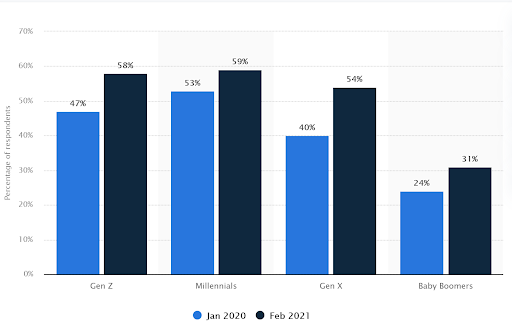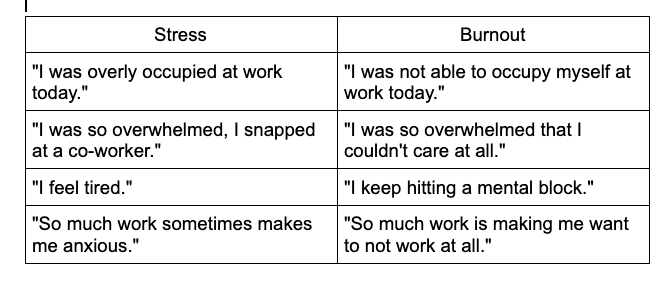Feeling as if work stress has become an indispensable part of your routine? Well, you might say, “Since when was it not?” but if stress is depriving you of your mental peace, upending your sleep cycle, and leaving you exhausted even on weekends — it’s a significant clue telling you your stress is turning into burnout.

Calendar – Calendar
There is statistical evidence of the Covid-19 pandemic making the burnout situation even worse. In addition, the stay-at-home lifestyle is a major disruption affecting both the physical and mental health of employees.

Percentage of U.S. employees who had feelings of burnout pre-COVID Jan. 2020 vs. Feb. 2021, by generation –
The above data shows that professionals across generations have reported comparatively higher burnout in February of 2021.
Millennials and Gen Z, which were already topping the charts, saw a similar incline, with burnout cases rising to 59%. That’s more than half of the most significant generations making up the modern workforce today. A sharp rise can also be seen for Gen X.
Working from home, professionals are reportedly putting in 15 extra hours at work every week. The extra hours logged for work result from overstretched work hours and the inability to disconnect from work past the log-out time. Not to forget the social isolation and emotional distress that tags along when you don’t meet your co-workers that often.
Burnout has its roots deep into jam-packed routines and an inherent workaholic culture, which is bursting at the seams for many.
While we can’t ask employees to forego the hard work, we can make strategic amends in work planning for remote teams and in-office employees. Laborious, inefficient work ultimately creates more work to handle in a day, which will tip you to burnout more often than not.
This article looks closely into what burnout is and how intelligent work planning can lift you out of burnout — alongside strategies to deal with burnout-causing emotions.
So, what does burnout feel like?
Work stress and burnout at work aren’t the same thing. Stress is part and parcel of being a professional but burnout is characterized by feelings you sure would want to avoid.
In the Leading Through Burnout study, which interviewed 35 Chief Medical Officers, striking dissimilarities were found. For example, about 69% of CMOs reported alarmingly high degrees of daily work stress, but only a very few reported burnouts. This is because most of these officers were emotionally equipped to handle their burnout-causing stress.
Let’s look at some commonly experienced feelings of stress and how they differ from burnout.

It’s also important to note that burnout changes how you think and act. Apparently, when you face consistent burnout, your brain naturally switches its behavior to an essentials-only mode. As a result, your creative side begins to diminish, and you don’t feel like investing in work anymore.
How does Inefficient Work Management Result in Burnout?
Handling workload efficiently and distributing work tasks wisely are two traits that every manager must possess. Disorderly management often contributes to increased process errors which eat away at employee productivity and morale. Lower productivity doesn’t take long before it creeps into the feeling of burnout.
Following are a few signs of burnout-causing management inefficiencies.
Unplanned work is more work.
Unplanned work is similar to packing your travel suitcase without conscience. You’ll never be able to fit your items properly if you randomly throw in stuff. You’d need to layout everything carefully so that every nook and cranny is utilized to the last inch.
Managers need to be especially aware of not stressing employees with the burden of unplanned work. Those last-minute tasks and shifting priority items can overwhelm employees with too much to deal with.
Other factors such as long feedback loops, not distributing work evenly throughout the week, and impromptu changes in work schedules only make the employees work for longer hours.
In the USA, employees work for 41.5 hours in a typical workweek on average. However, about 11% of employees reported working for more than 40 hours also. In Columbia, it can even stretch to alarmingly high 49.8 hours in a week.
Not setting clear work expectations.
Have you ever chased a single task for the entire week because the client wasn’t happy with your work? Post-delivery revisions are all right, but when you keep running in circles for the same task, it can feel extremely annoying.
Imagine working in an organization where this is the norm. Employees keep struggling with task revisions, simply because they’re not clear as to how to go about the task in the first attempt. Apparently, 46% of work stress is reportedly experienced due to overwhelming workload.
An overwhelming workload highlights a hidden anomaly in team communication. If managers are unable to assign work with crystal clear expectations, somewhere, the flow of communication is not appropriate. In addition, employees can feel a decline in their mental health in case they find their manager to not be a good communicator.
Repetitively working on tasks can cause frustration, exhaustion, and above all – loss of direction, which emotionally sabotages employee engagement.
Workplace chaos is contagious.
Mismanagement gives rise to the most significant productivity deterrent — chaos.
If the employees feel that they’re not being cared for at the workplace or the company’s management is bad at relaying information, it can lead to poor job satisfaction.
53% of Americans feel unhappy at work, and about 80% feel stressed in case the company communication isn’t effective. Being in an organization that feels chaotic can become a burnout furnace in no time.
Therefore, managing communication and professional relationships at work is extremely important in preventing burnout.
Smart scheduling for curbing burnout at work
Now that we have comprehended a few reasons why burnout occurs and the role of management in the same, let’s see how we can use smart scheduling to reduce burnout levels in employees.
Work-from-home isn’t work-forever.
As more teams work from home, managers need to be wary of the fact that employees find it hard to unplug from work and usually find their own rhythm. In addition, if task assignments are not moderated to last a workday, it can further intensify the problem of overworking.
Hence managers need to cut out work so that employees don’t have to extend their work-from-home hours beyond a certain point. An odd working Saturday shouldn’t hurt anyone, but every day shouldn’t feel like a stretch.
The best way to understand if employees are able to accommodate assigned workload healthily is by tracking logged-in hours and holding daily debriefs
